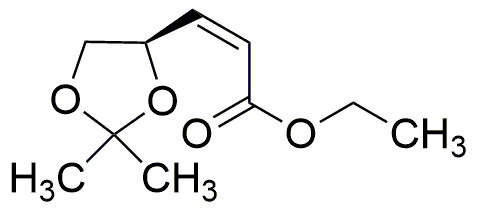Ethyl (R)-cis-3-(2,2-dimethyl-1,3-dioxolan-4-yl)propenoate is widely utilized in research focused on:
- Flavor and Fragrance Industry: This compound can be used as a flavoring agent in food products and beverages, providing a unique taste profile that enhances consumer appeal.
- Pharmaceutical Development: It serves as an intermediate in the synthesis of various pharmaceuticals, aiding in the development of new drugs with improved efficacy and safety.
- Polymer Chemistry: The compound can be incorporated into polymer formulations, enhancing properties such as flexibility and durability, which is beneficial in manufacturing plastics and coatings.
- Agricultural Chemicals: It is utilized in the formulation of agrochemicals, contributing to the development of more effective pesticides and herbicides that improve crop yield.
- Cosmetic Products: This chemical is also found in cosmetic formulations, where it acts as a stabilizer or emulsifier, improving the texture and stability of creams and lotions.
General Information
Properties
Safety and Regulations
Applications
Ethyl (R)-cis-3-(2,2-dimethyl-1,3-dioxolan-4-yl)propenoate is widely utilized in research focused on:
- Flavor and Fragrance Industry: This compound can be used as a flavoring agent in food products and beverages, providing a unique taste profile that enhances consumer appeal.
- Pharmaceutical Development: It serves as an intermediate in the synthesis of various pharmaceuticals, aiding in the development of new drugs with improved efficacy and safety.
- Polymer Chemistry: The compound can be incorporated into polymer formulations, enhancing properties such as flexibility and durability, which is beneficial in manufacturing plastics and coatings.
- Agricultural Chemicals: It is utilized in the formulation of agrochemicals, contributing to the development of more effective pesticides and herbicides that improve crop yield.
- Cosmetic Products: This chemical is also found in cosmetic formulations, where it acts as a stabilizer or emulsifier, improving the texture and stability of creams and lotions.
Documents
Safety Data Sheets (SDS)
The SDS provides comprehensive safety information on handling, storage, and disposal of the product.
Product Specification (PS)
The PS provides a comprehensive breakdown of the product’s properties, including chemical composition, physical state, purity, and storage requirements. It also details acceptable quality ranges and the product's intended applications.
Certificates of Analysis (COA)
Search for Certificates of Analysis (COA) by entering the products Lot Number. Lot and Batch Numbers can be found on a product’s label following the words ‘Lot’ or ‘Batch’.
*Catalog Number
*Lot Number
Certificates Of Origin (COO)
This COO confirms the country where the product was manufactured, and also details the materials and components used in it and whether it is derived from natural, synthetic, or other specific sources. This certificate may be required for customs, trade, and regulatory compliance.
*Catalog Number
*Lot Number
Safety Data Sheets (SDS)
The SDS provides comprehensive safety information on handling, storage, and disposal of the product.
DownloadProduct Specification (PS)
The PS provides a comprehensive breakdown of the product’s properties, including chemical composition, physical state, purity, and storage requirements. It also details acceptable quality ranges and the product's intended applications.
DownloadCertificates of Analysis (COA)
Search for Certificates of Analysis (COA) by entering the products Lot Number. Lot and Batch Numbers can be found on a product’s label following the words ‘Lot’ or ‘Batch’.
*Catalog Number
*Lot Number
Certificates Of Origin (COO)
This COO confirms the country where the product was manufactured, and also details the materials and components used in it and whether it is derived from natural, synthetic, or other specific sources. This certificate may be required for customs, trade, and regulatory compliance.


